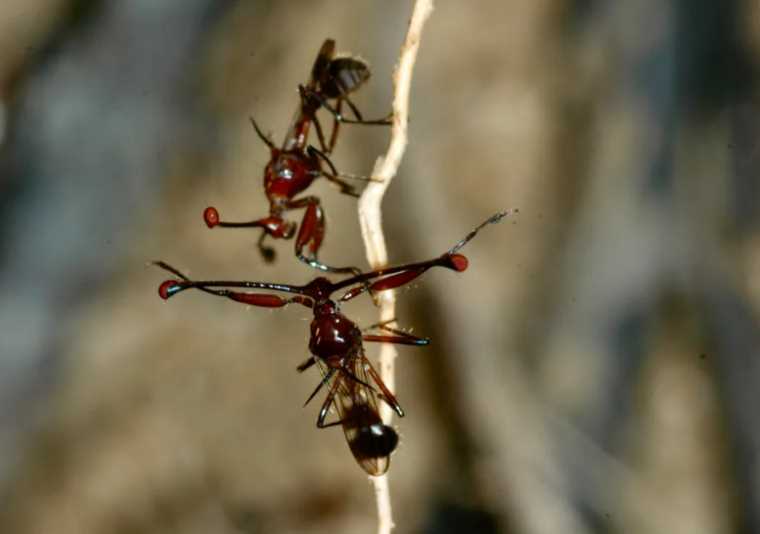Researchers from the State University of New York — Geneseo (SUNY-Geneseo) have determined that male stalk-eyed flies with shorter eyestalks, which make them less attractive to female flies, compensate by being more sexually aggressive than their longer eyestalk competitors.
Scientists had previously wondered why the genetic variant that leads to shorter eyestalks hadn’t died out from sexual selection long ago, given the female’s preference. Now, the SUNY-Geneseo team believes that the “selfish” gene that favors shorter eyestalks even though they are sexually disadvantageous has persisted due to the increased aggression by flies carrying the gene.
“It’s the first time I’m aware of that there’s evidence of a link between a selfish gene and aggressive behavior,” said Dr Josephine Reinhardt of the State University of New York — Geneseo, corresponding author of the article outlining the team’s research in a statement.
The researcher says it may seem logical to think that eons of natural selection would result in a genetic code that is in perfect harmony. However, genetic variants like the X chromosome, which gives stalk-eyed flies shorter eyestalks, show that genes can sometimes work at cross purposes.
“These driving X chromosomes are pretty interesting because they are an example of how parts of our genetic code aren’t necessarily working together but have their own selfish interests,” Reinhardt explained. “This is an extreme example, but simply carrying one of these selfish chromosomes impacts so many parts of these animals’ biology, even their behavior.”
Aggressiveness and Fighting Behavior Helps, But Size Still in Stalk-eyed Flies
In their published study, the SUNY-Geneseo team explained that there are a significant number of factors favoring the short eyestalk X chromosome. For example. The chromosome is described as a “meiotic driver.” This means that its alleles are overrepresented in the male’s sperm. As a result, it is more likely that some, if not all, of the fly’s offspring will be female.
“The driving X chromosome has a huge natural advantage because it passes itself on more than the fair 50-50 ‘coin flip’ rule of genetics that most of us learned in high school biology,” explained Reinhardt. “Up to 100% of a male’s offspring end up inheriting the X and therefore are female.”
In normal circumstances, a selection advantage that is this pronounced might lead to the total elimination of the competing gene until the species goes completely extinct. However, since the gene and respective traits still persist even in a minority capacity, the team wondered if something else was at work.
“Since [extinction] hasn’t happened, we’re interested in understanding what other traits could counteract that advantage,” Reinhardt said.
After selecting flies with both short and long eye stalks, the researchers placed them in situations where they were competing for the attention of female flies. As is often the case across numerous species, they immediately noticed that the larger male flies often intimidated the smaller flies regardless of eyestalk size.
“When fighters are mismatched, fights tend to end quickly, with the smaller male retreating,” Reinhardt explained.
However, the team also found that when male flies of similar sizes were matched, the males with the shorter eyestalks appeared to compensate by showing more aggression and fighting behaviors. They were also more likely to favor actual fighting over aggressive posturing, causing larger competitors to sometimes retreat. Still, the team observed that an overall body size disadvantage still impacted most outcomes.
“When a male with the driving X chromosome is fighting a male with similar-sized eyestalks, he is more aggressive,” said Reinhardt. “But because driving X males are on average smaller, it is likely still a disadvantage.”
Females Still Prefer Bigger
Of course, the researchers concede that their experiment was in a lab setting, not the fly’s natural habitat, which could have impacted their observations. They also note that female flies were not tested for aggressiveness. If X chromosome does increase aggression, Reinhardt says “that might impact females — whereas if it’s an indirect effect to do with the eyestalk size, it might not.”
In the study’s conclusion, the team summarizes their findings. While the male flies with the gene for shorter eyestalks had both genetic and competitive advantages that increased their odds of chasing away female flies’ competitors, there were still factors working against them as well. First, as previously noted, the males with bigger eyestalks tended to be larger overall, giving them a competitive advantage in fighting situations. Second, and perhaps even more significant, the females were more attracted to males with larger eyestalks.
So, in the world of stalk-eyed flies, at least, it appears that size still matters.
The study “Stalk-eyed flies carrying a driving X chromosome compensate by increasing fight intensity” was published in Frontiers of Ethology.
Christopher Plain is a Science Fiction and Fantasy novelist and Head Science Writer at The Debrief. Follow and connect with him on X, learn about his books at plainfiction.com, or email him directly at christopher@thedebrief.org.

